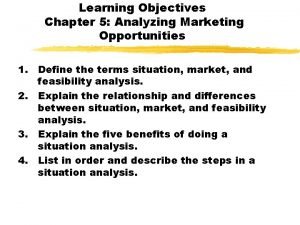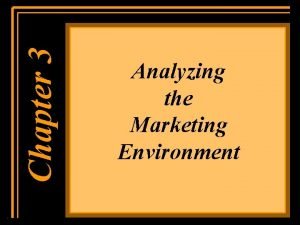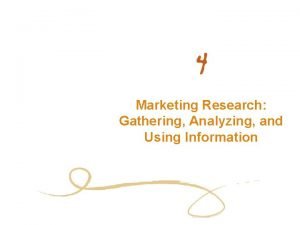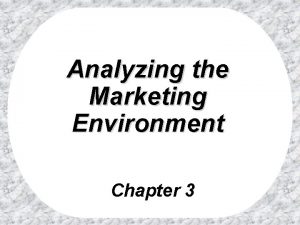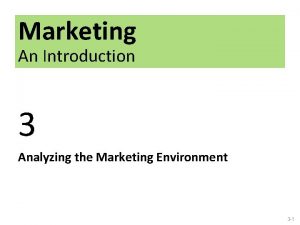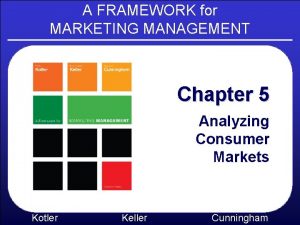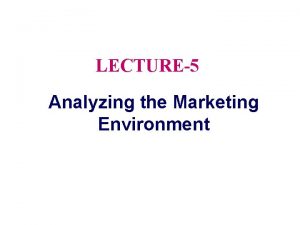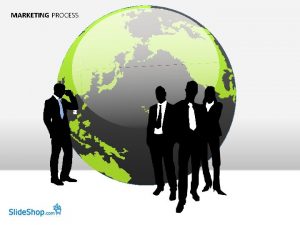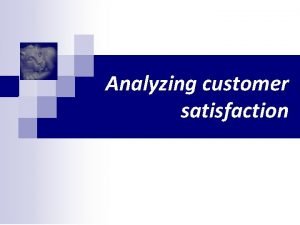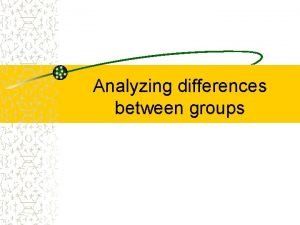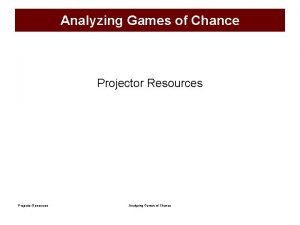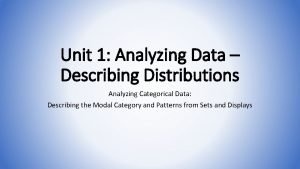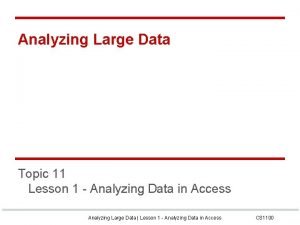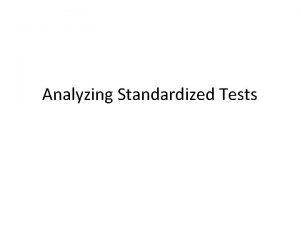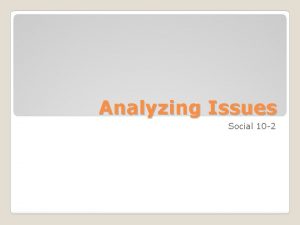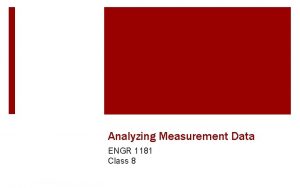The Marketing Process The marketing process Analyzing marketing








































- Slides: 40

The Marketing Process • The marketing process: – Analyzing marketing opportunities – Selecting target markets – Developing the marketing mix, and – Managing the marketing effort • Three key steps: – Market segmentation – Target marketing – Market positioning Figure 2. 4

Identifying Your Competitors • Companies or individuals which provide similar products, services, or benefits as perceived by your target customer.

Types of Competition Three Types 1. Direct (first level) Companies or individuals that offer the same products or services as perceived by the target customer. 2. Indirect (second level) Companies or individuals that offer the same benefits as perceived by the target customer. 3. Invisible competition People or businesses that have the capacity or desire to provide the same products, services or benefits that you do.

Competitive Intelligence • Competitive intelligence (CI) Ø The process of learning, collecting and using information about your competitors for the purpose of growing your business. • Requires a well-researched understanding of · Your target customers · Your current competition · Your future customer

Competitive Touchpoint Analysis ØA touchpoint is any contact that your customer has with any aspect of your competition. ØMaking a list of all the touchpoints allows you to identify your competitors’ strengths and weaknesses.

The Competitive Edge Niche or Focus Strategy Three Broad Competitive Strategies Differentiation Strategy Cost Leadership Strategy

Competitor Analysis Two methods to evaluate potential competitors are: 1. Competitive test matrix Ø A grid showing the strengths and weakness of your competitors. 2. Competitive SWOT Ø For each competitor, evaluate its internal strengths and weaknesses and external opportunities and threats.

The Competition Life Cycle Embryonic Growth Key Stages of the Life Cycle Mature Decline

Maturity Growth Embryo Decline C O MP E T I O N C U S T O ME R S Your Competitive Positioning Strategy Figure 5. 4

TARGET MARKET (6 - O’s) SELLER’S MIX (The P’s) UNCONTROLLABLE FACTORS *Demographics *Globalization*Political *Economy *Environmental * Research *Legal * Government * Technology * War * Terrorism

Reviewing the Outputs Marketing Objectives & Strategy Marketing Mix Elements Product Pricing Place Promotion - Product types - Product tangibility - Product lifecycle - New product development - Price Elasticity (Sensitivity) - Pricing strategies (lifecycle/product type) - Pricing policies - Types of distribution - Distribution strategies (consumer & business) - Types of promotion - Promotional strategies (consumer & business) Analytic Tools: • Research • Balance & Gaps Assessment • Measurement, Monitoring & Evaluation

The Four P’s of the Marketing Mix • The marketing mix: – Set of controllable, tactical marketing tools – Product, price, place, and promotion – Blended to produce the desired response in the target market • Internal consistency helps to be successful • Represents the seller’s view of the market Figure 2. 5

The 4 P’s Versus 4 C’s • A different (buyer’s) way of looking at the four P’s Product Customer solution Price Customer cost Place Convenience Promotion Communication

Four Service Characteristics • Service: any activity or benefit that one party can offer to another that is essentially intangible and does not result in the ownership of anything Figure 10. 5

Three Levels of Product • Core product: – Problem solving services or benefits of consumers’ purchase • Actual product: – A product’s parts, quality, features, design, brand name and other attributes received • Augmented product: – Additional consumer services and benefits built around core and actual product – Add value/ differentiate product from competition

The Total Product Concept A total bundle of physical, service, and symbolic characteristics designed to satisfy customer wants. Brand Warranty and service 10 -3 Physical or Functional Characteristics of a Good or Service Product image Package and label

Marketing the Product: Brand Equity Represents the value customers (and the stock market) place on the sum of the history the customer has had with a brand. Brand Equity Brand awareness Perceived quality Brand association Brand loyalty How well and widely a brand is known Customer assessment of how well a product meets expectations Connections consumers make between products and their perceptions (Brand Image) Level of commitment a consumer has to a brand (familiar, preference and insistence) 10 -11

Stages in the Product Life Cycle A product’s progress through introduction, growth, maturity, and decline stages. Objective: Stimulate Demand Stimulate purchase & repurchase Overlap of Life Cycle for Products A and B Protect volume from competition Protect volume from shifting consumer preference

What is a Price? • Price: the amount of money charged for a product or service, or the • • sum of values exchanged for the benefits of having or using the product or service Also known as rent, tuition, fee, fare, rate, • Pricing best practices: interest – Develop a 1% pricing mindset Historically, most pricing – Consistently deliver more value was dynamic, arrived at through negotiation – Price strategically, not Fixed price policy more opportunistically recent – Know your competition Price is the only – Make pricing a process marketing mix element that produces revenue Source: Paul Hunt, Strategic Pricing Division, The therefore it is a key Advantage Group, Toronto, Ontario element in the strategy

Costs • Costs set the floor, or lowest amount that should be charged Ideally covering all costs plus margin for profit • Fixed costs: costs that do not vary with production - overhead (rent, utilities, insurance, management salaries) • Variable costs: costs that vary directly with the level of production (raw materials, labour, supplies) • Total costs: the sum of fixed and variable cost. Average cost to produce decreases as volumes increase (Economies of scale)

PRICE OPTIONS • • Prestige Odd Externally Guided Skim the Cream Penetration Full Cost Demand

New-Product Pricing • Market skimming pricing: setting a high price to skim maximum revenues from segments willing to pay (new technology) • Market penetration pricing: setting a low price for a new product to attract a large number of buyers and achieve a large market share • Skimming price drops in steps Advantage to be gained by large volumes early in life cycle Figure 7. 7

Price Adjustment Strategies Discount and Allowance pricing Reducing prices to reward customer responses such as paying early Segmented pricing Adjusting prices to allow for differences in customers, products, or locations Psychological pricing Adjusting prices for psychological effect; reference pricing Promotional pricing Temporarily reducing prices to increase short-run sales Geographical pricing Adjusting prices to account for geographic location of customers International pricing Adjusting prices for international markets Table 12. 2

Promotional Mix • Promotional mix The key to connecting with customer is your promotional mix—all the elements that you blend to maximize communication with your customer.

PROMOTION • Direct marketing: – Direct communications with targeted individuals to obtain an immediate response and lasting customer relationships • Integrated marketing communications: – Coordinating/integrating to deliver a clear, consistent, and compelling message on all communication channels – Leverage: the overall effect is greater than the sum of its parts

Steps in Developing Effective Communications • Identifying the target audience: – Will determine what, how, when, where, and who will say it • Determining the desired response: – Will depend on what “stage” of the purchase decision process the buyer is presently at Buyer Readiness Stages: The stages that buyers normally pass through when making purchase decisions Figure 15. 3

PROMOTION Advertising Publicity Personal Selling Special Promotions

PROMOTION Advertising paid, non-personal Institutional Brand Sales Classified

Relationship between Advertising and the Product Life Cycle • For product advertising to be effective it must accomplish three key objectives: Inform Growth Remind Maturity Sales Introduction Persuade Informative Advertising Persuasive Advertising Reminder-Oriented Advertising Time Decline

PROMOTION Publicity not paid, non-personal * high credibility * off-guard * dramatization

Public Relations • Public relations: – – Building good relations with the company’s various publics obtaining favourable publicity, building a good corporate image, and handling or heading off unfavourable rumours, stories, and events • Public relations functions: – – – Press relations Product publicity Public affairs Lobbying Investor relations Development • Public relations tools: – – – News, speeches Special events Mobile marketing Published materials Website Public service activities

PROMOTION Personal Selling person-to-person *Product awareness & preference *Closing a sale *Negotiating price and terms * High end of preference scale

Customer Service and Quality Some Market Facts If you provide quality service, you can: • Charge up to 10 percent more for your product or servic · Increase sales growth · Reduce costs · Gain new customers · Make word-of-mouth advertising work for you AND • Increase Profits!

PROMOTION Special Promotions short term buy incentives • Consumer • Trade • Sales-force promotions

Promotion in Cyberspace Paid media advertising Promotional Mix Working visibly Industry Literature Branding Yourself Trade Shows Business Cards Point-ofpurchase displays Promotional Mix Catalogues Discount Coupons Personal Selling Free Ink and Free Air Direct Mail Money-Back Guarantees

Integrated Marketing Communication (IMC) Applied Advertising Purpose: Awareness and preference building Timing: Introduction and Growth Stages Types: Informative, Persuasive, Reminder, Retail Sales Promotion Purpose: Incentive Timing: Late Growth, Maturity, Decline Stages Types: POP, Specialty, discount and loyalty programs Public Relations Purpose: Fostering product and company goodwill Timing: Introduction and Growth stages (builds credibility) Types: Sponsorship, Publicity Direct Response Purpose: Stimulate immediate sales Timing: Introduction, Growth, Maturity Stages Types: Direct Mail, Internet banners, TV Personal Selling Purpose: Complex, customized sales, personal references Timing: Introduction, Growth and Maturity Stages Types: Order processing, Creative selling

Guerrilla Marketing • Guerrilla Marketing An important part of your promotional mix will be your “guerrilla marketing” promotional strategies—unconventional methods of getting the customer’s attention at minimal cost.

Push Versus Pull Promotional Strategies • • Refers to the direction of promotional effort Exists as a range, yet most companies use a combination of both Consumer goods use primarily pull; advertising Industrial goods use primarily push; personal selling Figure 15. 4

Plotting Your Future Checklist q What is your marketing strategy? q What prices will you charge? q What are your promotional mix, goals and objectives? q What stimulates your target market to buy or use your product or service? q What has your primary and secondary research told you about promoting your business?

Plotting Your Future Checklist q Develop a promotional strategy for your business. q How will you cost out your promotional budget? q Does your business have a unique twist for a possible publicity story? q Why did you select the business name you are using?
 Analyzing marketing opportunities
Analyzing marketing opportunities Chapter 3 analyzing the marketing environment
Chapter 3 analyzing the marketing environment Analyzing and using marketing information
Analyzing and using marketing information Managing marketing information to gain customer insights
Managing marketing information to gain customer insights Analyzing the marketing environment
Analyzing the marketing environment Analyzing the marketing environment
Analyzing the marketing environment Chapter 5 analyzing the marketing environment
Chapter 5 analyzing the marketing environment Hình ảnh bộ gõ cơ thể búng tay
Hình ảnh bộ gõ cơ thể búng tay Ng-html
Ng-html Bổ thể
Bổ thể Tỉ lệ cơ thể trẻ em
Tỉ lệ cơ thể trẻ em Chó sói
Chó sói Tư thế worm breton
Tư thế worm breton Chúa yêu trần thế alleluia
Chúa yêu trần thế alleluia Các môn thể thao bắt đầu bằng tiếng nhảy
Các môn thể thao bắt đầu bằng tiếng nhảy Thế nào là hệ số cao nhất
Thế nào là hệ số cao nhất Các châu lục và đại dương trên thế giới
Các châu lục và đại dương trên thế giới Công của trọng lực
Công của trọng lực Trời xanh đây là của chúng ta thể thơ
Trời xanh đây là của chúng ta thể thơ Mật thư anh em như thể tay chân
Mật thư anh em như thể tay chân Làm thế nào để 102-1=99
Làm thế nào để 102-1=99 độ dài liên kết
độ dài liên kết Các châu lục và đại dương trên thế giới
Các châu lục và đại dương trên thế giới Thơ thất ngôn tứ tuyệt đường luật
Thơ thất ngôn tứ tuyệt đường luật Quá trình desamine hóa có thể tạo ra
Quá trình desamine hóa có thể tạo ra Một số thể thơ truyền thống
Một số thể thơ truyền thống Cái miệng nó xinh thế
Cái miệng nó xinh thế Vẽ hình chiếu vuông góc của vật thể sau
Vẽ hình chiếu vuông góc của vật thể sau Nguyên nhân của sự mỏi cơ sinh 8
Nguyên nhân của sự mỏi cơ sinh 8 đặc điểm cơ thể của người tối cổ
đặc điểm cơ thể của người tối cổ Thế nào là giọng cùng tên? *
Thế nào là giọng cùng tên? * Vẽ hình chiếu đứng bằng cạnh của vật thể
Vẽ hình chiếu đứng bằng cạnh của vật thể Vẽ hình chiếu vuông góc của vật thể sau
Vẽ hình chiếu vuông góc của vật thể sau Thẻ vin
Thẻ vin đại từ thay thế
đại từ thay thế điện thế nghỉ
điện thế nghỉ Tư thế ngồi viết
Tư thế ngồi viết Diễn thế sinh thái là
Diễn thế sinh thái là Dot
Dot Số.nguyên tố
Số.nguyên tố Tư thế ngồi viết
Tư thế ngồi viết
